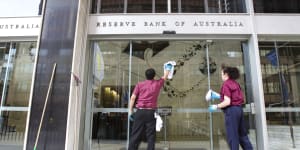Chalmers will introduce to parliament a series of changes to the RBA’s 64-year-old governing legislation that will also give the bank new powers to deal with emerging payment systems such as Apple Pay and Google Pay.

More than a quick clean:Treasurer Jim Chalmers will unveil the biggest changes to the Reserve Bank since its creation.Louie Douvis
The Coalition is likely to support much of the legislation as the major parties seek to avoid any minor party tinkering,but there are concerns within the Liberal Party about government appointments to the boards that will oversee both the bank and monetary policy.
The review of the Reserve Bank,,recommended sweeping changes to the institution,which,unlike its overseas peers,had not undergone an independent evaluation since the early 1980s.
The biggest single change will be the creation of a board that will set official interest rates,while a governance board will oversee the RBA’s day-to-day operations. Half of the Reserve’s 1575 staff are involved in operations,such as the nation’s payment system,rather than economists and analysts.
The review argued a separate monetary policy board would bring Australia into line with world’s best practice and enable its members to focus more intently on the state of the economy and interest rate settings.
The RBA practice of meeting monthly,which is unlike almost every other major central bank in the world,will be replaced with a move to eight,two-day meetings a year.
RBA governor Michele Bullock revealed this week the meetings,beginning in February,would start on Monday afternoon with staff presentations and an extended discussion on the outlook for the economy.
“The board would then reconvene on the Tuesday morning to consider the policy decision. This will have the benefit of members being able to reflect overnight and raise any further issues or questions before the policy decision is made,” she said.
While changing the operations of the Reserve,Chalmers will also give it more powers to deal with the rapidly evolving payments system.
From haircuts to eating out,the RBA governor says soaring prices are a homegrown problem hinting more rate rises might be needed.
The bank will be able to regulate new and emerging payment systems,covering not only existing networks such as Google Pay,but future digital payments.
While dealing with new ways to buy goods and services,the RBA is already working on the end of the cheque system,which the government is planning to wind up by 2030.
The number of cheques written by Australians fell to 453,000 in September – the lowest monthly figure on record. Over the past year,cheques have fallen by 22 per cent,while over the decade they have declined by 89 per cent.
Apart from creating a separate interest rate-setting board,Chalmers will narrow the Reserve Bank’s charter in line with recommendations from the review.
Since its creation,the bank has had a triple mandate to stabilise the currency,maintain full employment and make decisions to boost the “economic prosperity and welfare of the people of Australia”.
Stabilising the currency has,over the years,in effect become targeting the rate of inflation. The Reserve Bank’s 2-3 per cent inflation target forms part of an agreed statement between the bank’s governor and the treasurer of the day.
Chalmers,who in the next few weeks will formalise his statement with Bullock on the bank’s operation,will change the RBA’s mandate to price stability and full employment.
The narrowing of the mandate has caused some concern within the Liberal Party that the bank’s interest rate policy board may reduce its focus on keeping inflation between 2 and 3 per cent. This has fed into concerns about possible appointments to the board.
The changes will also include removing the ability of the government to veto a Reserve Bank decision. This has been part of the bank’s overriding legislation since its inception but has never been used.
One of the RBA review’s key criticisms of the bank was the way it communicates with the public. One part of the change to the bank’s operations will be press conferences following its regular meetings,rather than just a press release.
Bullock,who has come under fire after,this week admitted that the bank had to improve the way it talked to Australians about its actions.
“I think this is our real challenge because I don’t think we really hit the mark there yet,” she said.
Cut through the noise of federal politics with news,views and expert analysis..